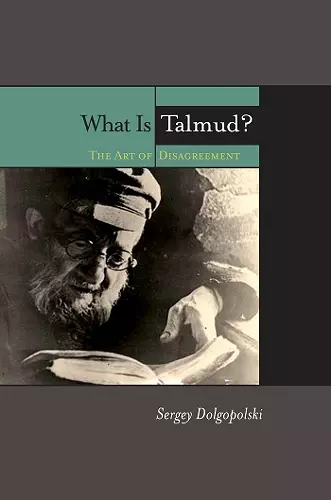What Is Talmud?
The Art of Disagreement
Format:Hardback
Publisher:Fordham University Press
Published:15th May '09
Currently unavailable, and unfortunately no date known when it will be back

True disagreements are hard to achieve, and even harder to maintain, for the ghost of final agreement constantly haunts them. The Babylonian Talmud, however, escapes from that ghost of agreement, and provokes unsettling questions: Are there any conditions under which disagreement might constitute a genuine relationship between minds? Are disagreements always only temporary steps toward final agreement? Must a community of disagreement always imply agreement, as in an agreement to disagree?
What is Talmud? rethinks the task of philological, literary, historical, and cultural analysis of the Talmud. It introduces an aspect of this task that has best been approximated by the philosophical, anthropological, and ontological interrogation of human being in relationship to the Other-whether animal, divine, or human.
In both engagement and disengagement with post-Heideggerian traditions of thought, Sergey Dogopolski complements philological-historical and cultural approaches to the Talmud with a rigorous anthropological, ontological, and Talmudic inquiry. He redefines the place of the Talmud and its study, both traditional and academic, in the intellectual map of the West, arguing that Talmud is a scholarly art of its own and represents a fundamental intellectual discipline, not a mere application of logical, grammatical, or even rhetorical arts for the purpose of textual hermeneutics.
In Talmudic intellectual art, disagreement is a fundamental category. What Is Talmud? rediscovers disagreement as the ultimate condition of finite human existence or co-existence.
"What is Talmud? The Art of Disagreement is an innovative and provocative analysis of the intellectual art and practice of Talmud, exemplified by the fifteenth-century Castilian commentator, Izh.ak(DOT UNDER H) Canpanton. Embracing a sophisticated conceptual methodology, Dolgopolski sets talmudic rhetoric in contrast to the dominant Western philosophical concern for agreement. Influenced by Nietzsche and Heidegger, the author combines philology and anthropology in an attempt to provide an alternative to viewing the Talmud primarily as a traditional source or a historical object. This work of speculative juxtaposition promises to expand the horizon of philosophic hermeneutics and rabbinic dialectic, and to highlight the value of disagreement to human discourse more generally: not only is it important to agree to disagree, but it is precisely disagreement that facilitates a deeper sense of agreement." -- -Elliot R. Wolfson New York University "With the loss of the most seemingly inconsequential of words, the "the" before "Talmud," a world, Sergey Dolgopolski shows us, can be gained. Leaving behind what was previously understood as a circumscribed text or body of thought, we find a new and potent mode of thinking, different from logic, hermeneutics and philosophy, which has implications far beyond those of theological disputation. Drawing on the most advanced contemporary continental theory to revive the forgotten lessons of the 15^th -century Sephardic sage Canpanton, Dolgopolski provides stunningly original and profoundly unsettling insights into "the art of disagreement." -- -Martin Jay University of California, Berkeley "In both engagement and disengagement with post-Heideggerian traditions of thought, What Is Talmud redefines the place of the Talmud and its study in the intellectual map of the West." -Shofar "Explores Talmudic interpretation through a study of Rabbi Izhak Canpanton and his followers in 15th-century Spain." -The Chronicle of Higher Education "What is Talmud? is a provocative and strikingly original work that defies disciplinary boundaries. This intensive encounter staged between Talmud and post-structuralist thought not only gives us an illuminating new perspective on each of these traditions, it also provides a lucid and sophisticated reconceptualization of rhetoric that emerges out of their mutual confrontation. The relevance of post-structural thought to Talmud is clearly demonstrated here. However, what is most extraordinary to me is the powerful (and persuasive) claim that philosophy must itself seriously engage Talmud in order to move beyond the impasses of post-Heideggarian thought." -- -David Bates University of California, Berkeley "Dolgopolski's argument that Talmud offers an alternative to philosophy in its radical past-ness is brillant and ground-breaking." -- -Bruce Rosenstock University of Illinois, Champaign/Urbana "Dolgopolski brilliantly maps how each subtle shift in twentieth-century philosophy has established the groundwork for presenting Talmud as a third way between philosophy and rhetoric." -- -Zvi Septimus The Journal of AJS Review
ISBN: 9780823229345
Dimensions: unknown
Weight: unknown
320 pages